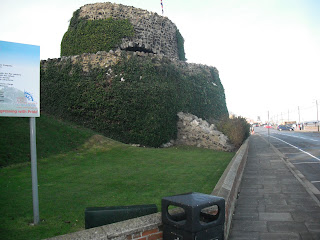Walk 53 Hessle to the east of Kingston Upon Hull
(First leg of English coastal walk – Broadstairs in
Map: L/R 107
Distance: about 8 miles
Difficulty: easy, flat
Terrain: paths and pavements
Access: Parking at Hessle Park and Ride.
Public transport: Buses from the Park and Ride or from Hessle
The walk starts eastwards along the north of the Humber near
Hessle following the Yorkshire Wolds Way to start with then on to the Trans
Pennine Trail. On the way into Hull there are a number of
derelict buildings by the river side (which may have been cleared by now) – one of them belonged
to The Seafish Industry Authority now located in Edinburgh and Grimsby.
Hull is an interesting place and does not deserve the sneer I get when I mention it as a place to visit. Along the river front is the sculpture of some characters looking out to sea. It depicts a family from northern Europe having temporarily left ship here before going to Liverpool then by ship to America. From 1836-1914 over 2.2 million people passed through Hull en route to a new life in the USA, Canada, South America and Australia. The Wilson Shipping Line leased a separate landing wharf at Hull to cope with the numbers passing through. The outbreak of the First World War and immigration acts in the Americas almost ended the migrations overnight.
Further along near the harbour a inch anti-submarine gun points out to sea. It was recovered from the wreck of the SS Gretorria sunk in action on 27th September 1917. The large wheel of a superbly preserved horizontal steam engine is a short walk from here at the Humber Dock Promenade. The single cylinder winding engine was originally sited at the Victorian Dock Basin further to the east. It was made in 1866 and was used to draw vessels up from the Humber for repairs and refitting. It was relocated here in 1987.
The Humber Dock promenade goes inland and a walk into the city is convenient from here. The modernised space with fountains is attractively laid out.
Hull City Centre has some impressive buildings. There has been a settlement here for at least 800 years. As a port it predates Liverpool and has maintained links with the major Baltic and Scandinavian trading centres. The city is famous for William Wilberforce (anti slavery campaigner) whose birthplace can be found in the Old Town. Other famous people include Philip Larkin the poet (a Larkin trail was set up around the city soon after I walked there), John Prescott, John Venn (of Venn diagram fame), David Whitfield (the singer), Andrew Marvell, Andrew Motion and Stevie Smith (all poets), John Alderton, Ian Charmichael (actors) and the flying pioneer Amy Johnson.
Returning to the promenade and walking eastwards are the Victorian Pier and part of the old Victorian Dock. A statue of a man leaning out towards the sea is called Voyage. There is a sister sculpture in Vik on the south coast of Iceland and they symbolise 1000 years of trading with Iceland. It was erected after the 30 year dispute with Iceland - the ‘Cod Wars’.
Further along is ‘The Deep’ an aquarium praised for its architecture. It houses an impressive collection of fish – over 3500 types. A sculpture of a Grey Reef Shark stands on the riverside of the building. From here there is a swing footbridge which I was fortunate enough to see open and let shipping through.
The walk from here is a pleasant one with very helpful information boards detailing the history of each section. These include: a foreign cattle depot which once imported cattle from the continent – in 1887 52,000 sheep 2000 pigs and 9000 cattle were brought in and slaughtered on shore - refrigeration in ships stopped this trade. Several timber ponds used to store and handle wood – these were completely drained in 1991 and houses built and old flood gates which were superseded in 1987 by a new flood defence to protect the houses built on the old Victorian Docks.
Part of this new part of Hull is celebrated by a sculpture on the promenade commissioned by local residents to depict the movement of the sea and sky.
When I walked this stretch the remains of broken down buildings on the foreshore made a rather sorry sight. I spoke to a local man who told me that there were plans to turn this area into a 24 hour container port. Local people were vigorously fighting these proposals. I wonder if they succeeded?
It is worth a stroll along to the Port of Hull which is one of the leading trade ports in the UK. There are regular short crossings to Europe, Scandinavia and the Baltic states. It is the UKs foremost port for handling timber and related products. It is also the only passenger port on The Humber – one million passengers a year use the P&O super cruise ferries from Hull to Rotterdam. These large ships can be seen at close proximity.
This marks the end of the walk and a return to Hull centre.
Photos show: Horizontal steam engine on Hull dock promenade, swing footbridge for shipping near The Deep, old floodgates and a ship in the Port of Hull dock.






































